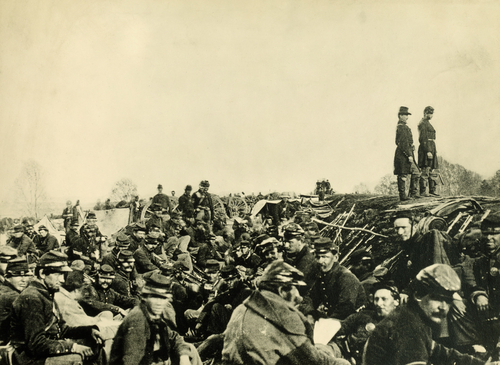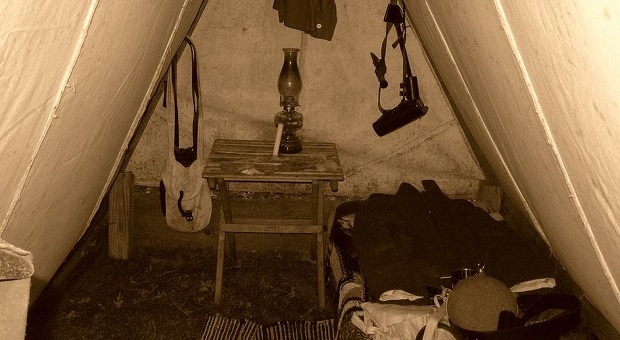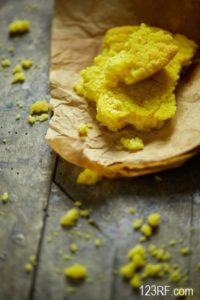The Civil War was brutal. That’s all there is to it.
If you’ve seen The Free State of Jones, even the first fifteen minutes of the movie bring home some of the atrocities that men – on both sides – had to endure. While it’s true that the Union soldiers were generally better fed than the Confederate soldiers were, Neither side was eating steak and eggs, at least not with any kind of regularity. Because an army really does march on its stomach, food supplies going both directions were interrupted as often as possible.
Unfortunately, that often meant burning fields and slaughtering animals, leaving them to rot, as a regiment passed through an area, in order to keep the other side from eating. The casualties of those actions weren’t just soldiers – the families who depended upon those animals and crops to exist also starved.
How did they manage to survive? Keep reading to find out!
Because food conditions became so brutal, especially in the South, both soldiers and families had to learn how to survive with very little food. I don’t think I know a single person who hasn’t seen Gone with the Wind, and though it’s not one of my favorite movies, it does point out some valid points.
The land was destroyed and plundered. A woman who had been raised “gently” aka- spoiled, and had no skill or knowledge whatsoever, learned what she needed to in order to survive. Scarlet isn’t necessarily the greatest example of how things went down simply because she was entitled and duplicitous, but the movie did have a realistic element to it.
So what was a man to do if he was on the march and had very little time to cook, and very few ingredients to do it with? And what about the women and infirm left at home?
How did they live? The answer is: simply and with what little they had on hand.
The one advantage that both sides had was that the country was still agricultural. People, at least in the part of the country where they were fighting, weren’t dependent upon outside sources for survival. Family or estate gardens were the norm rather than the exception and fruit trees and wild berries grew in abundance.

The marching soldiers weren’t quite so lucky, and it wasn’t always because food was scarce. There was also the fact that most of the men had no idea how to cook; they’d never had reason to learn because they had women or servants to do that.
The North had an advantage here at the start of the war because they had the United States Sanitary Commission watching out for them. They were a system of volunteers that were trained to find and distribute food to soldiers in the field.
They knew about what was in season where, and how to preserve it and transport it. It was their sole job to keep the soldiers constantly fed. That doesn’t mean the food tasted good, though, and they didn’t always come through so the soldiers were left to their own devices.
It was so bad that a hotel owner named Sanderson proposed that they actually teach two people per 100 to cook so that somebody had at least rudimentary skills. He also wrote a cookbook that offered suggestions on cooking methods and some simple recipes.
On the other hand, the Confederacy was a ragtag team who came together as farmers, miners, plantation owners, and other working men who were fighting for what they believed in. They weren’t soldiers and didn’t have any sort of organized system in place. They ate on the run and were dependent on what they could catch, hunt, pick, or pilfer. Families along the way were often sympathetic to the cause and would offer what they could.
Either way, if you have an entire army of people who are great at shooting a rabbit but have no idea how to cook it, you can imagine that foodborne illness was a serious issue.
The typical daily allotment for a confederate soldier was twelve ounces of back and a pound of cornmeal (also called Indian meal) or hardtack. In the beginning, sugar, beans and coffee were part of the allotment, but faded out as food supplies dwindled.
Union soldiers received salted pork or beef, coffee, sugar, vinegar, salt, and dried fruits and veggies when they were in season. There were also civilian merchants called sutlers that set up shop in camps and sold canned fruit, sugar, tobacco, and coffee.
Hardtack was a staple on both sides and often was the only thing that stood between a man and starvation, though it hardly qualified as food and had practically no nutritional value other than carbohydrates because it was flour and water. Both sides also carried a canvas bag with buckles called a haversack that held their food and anything else they needed to survive for a few days on their own.
Finally, Confederate soldiers would often trade tobacco to Union soldiers for coffee beans, though it was done in secret because, obviously, fraternization was frowned upon.
I think it’s critical to remember here that these were brothers fighting brothers. Unlike other wars, these men were still countrymen, though their convictions had brought them to war. Sometimes, men managed to find uneasy peace long enough to help each other.
By the end of the war, things were so bad that there were food riots in many southern cities because food lines had been severed, personal food sources had been pillaged and/or destroyed, and people were starving. Even rats were fair game.
Here are a few recipes that soldiers used, and note that there are often no amounts listed but it was just a “make-do” type of cooking:
Battlefield Cornbread
Mix cornmeal with enough pork fat to make a stiff batter. Spin your bayonet in it until coated, then hold over the fire to cook the bread.
Indian Sagamite
This was simple – three parts corn meal and one part brown sugar, browned in a skillet. In small amounts, it allays hunger and thirst, making it a good food for scouts.
Coffee Substitute
Wash ripe acorns in the shell dry them, and parch them until the open. Take the shell off and roast the nuts with a little bacon fat and you’ll have a “splendid cup of coffee.”
Chicory was also used, and chicory coffee remains a southern thing.
Plain Irish Stew (Feeds 50)
Cut fifty pounds of mutton into ¼-pound chunks. Put them in a pot and add twelve pounds of whole potatoes along with 8 tablespoons of salt and three teaspoons pepper. Cover with water, about a half-pint to each pound of meat. Light the fire and simmer (well, it says 1-1 ½ hours of gentle ebulation).
Hard Tack
Dissolve 1 ½ tbsp. salt in 1 cup water. Mix into 5 cups flour. Knead into a dough and roll out to 1/3-inch thickness. Cut into 3-inch squares and pierce each with a fork or whatever is available.
Cook on low temperature of 250 degrees to prevent burning for at least 4 hours, turning over halfway through.
Johnnycakes
- 2 cups boiling water
- 1 teaspoon salt
- 1 tablespoon sugar
- 1 tablespoon butter
- 1 cup cornmeal
- 1 tablespoon bacon fat
Bring the water to a boil and slowly add the cornmeal. Cook for 5 minutes then add the remaining ingredients. Place a 3-oz. scoop into a hot greased skillet and cook for five minutes on each side or until each side is lightly browned.
Confederate Biscuits
- 2 cups flour
- 2 teaspoons baking powder
- ¼ teaspoon baking soda
- 1 teaspoon salt
- 6 tablespoons shortening (lard or butter will do. Butter will make them heavier and crispier)
- 2/3 cup buttermilk
Stir together dry ingredients. Cut in shortening until mixture is the consistency of meal. Stir in the buttermilk. Form into a ball and place on a floured surface. Knead a few times – not much or they’ll be heavy. Pat out into about ½-inch thick. Cut with a cup, tin, or biscuit cutter and place on an ungreased baking sheet. Bake at 450 degrees for 8-10 minutes.
Fried Catfish
- 2 catfish fillets
- 1 cup flour or cornmeal
- salt and pepper
- 1 cup pork fat
Melt fat in a cast-iron skillet. Mix dry ingredients well, then roll the catfish filets in them. Put in skillet carefully – the grease is hot. Cook on each side for 5 minutes.
Turnip Greens
- 2 bunches turnip greens
- 4 turnips
- 1 onion (sliced)
- 1 tablespoon salt
- 1 piece fatback
- 4-5 cups water, enough to keep them from burning
Rinse greens well under cold water. Add greens, turnips and onions to boiling water with fat back and salt. Cook for 20 minutes or until turnips are tender and serve.
These are just a few basic recipes that were common, simple foods during the Civil War, and all of them except the hardtack remain common Southern foods today.
As a matter of fact, the biscuit recipe above is mine, handed down to me twenty-five years ago from my father-in-law, who learned it from his grandmother. And the turnip greens recipe is my husband’s, and he learned it from his grandmother. Imagine my surprise when I found near-identical ones on a Civil War site!
I shouldn’t have been surprised, though. Many of my recipes are ones that have been handed down to me from my mother, grandmother, or ex father-in-law, all of whom learned them from their elders. Unfortunately, most of these recipes that were standard foods have been lost.
Biscuits come in cans and catfish comes from a restaurant. Not in my world, though – everybody should at least know how to make them, because they’re easy and will keep you from starving if SHTF.
Because I think everybody should know about how to take care of themselves, I share several of my recipes in my book, Forgotten Lessons of Yesterday, along with many other skills that I was fortunate enough to learn from them. It’s a diverse collection of some of my most valued skills, and I’m proud to share them, as well as the free special reports that expand on what the book has to offer.
Check it out – I didn’t mean for this to turn into a shameless plug, but I’m passionate about these skills and want to share them with everybody!












Jesse Douthit | July 17, 2017
|
Growing up in rural NW Florida in the early fifties and sixties, the skills required to plant, grow, harvest, prepare and serve were all part of the everyday life for my two sisters and me. Memories grow dim but enough remains that some of these skills are retained.
Unfortunately both my parents and sisters are now gone and it remains to me to retain skills as well as fond memories
Sandra Fenter | July 17, 2017
|
In confederate biscuit recipe it calls for 2 teaspoon baking powder and 1/4 tsp baking powder. Should one of those be baking soda or something else?
Arline Middaugh | July 17, 2017
|
It should be 1/4 tsp. Baking soda.
robert | July 17, 2017
|
1/4 tsp baking soda
Erin | July 17, 2017
|
Confederate biscuits – looks like the dry ingredients are wrong for the baking powder. Is one supposed to be baking soda?
Survivopedia | July 18, 2017
|
Yes, Erin, it’s backing soda, we made the correction. Thank you noticing and reporting the error. 🙂
Al | July 17, 2017
|
Lincoln started the “civil” war. Prior to Lincoln’s election, the North and South had a signed peace agreement that essentially stated that a build up of soldiers and weaponry (cannons, etc) along the Mason-Dixon on either side would be cause for war. Lincoln was elected but would not “take” office for 4 more days, when he wrote a secret letter to the commander of Fort Sumpter telling him to immediately bring troops and weaponry into the fort, which the commander did. And as they say, “you know the rest of the story”. It is in the national archives. By the way, Lincoln also tried to send all of the blacks out of the US. He bought land in central America for them. They refused of course.
Bill in Idaho | January 11, 2019
|
Don’t Forget – Lincoln was Also an avid student / disciple of Karl Marx and Freidriche Engels.
Dennis | January 28, 2020
|
Hi Bill! If you’re still out there, I’d be interested in learning more about Lincoln’s Marxism. Could you point me to 2-3 resources for this information? Thanks.
R Will Anderson | July 17, 2020
|
A series of books by Dr. Thomas J. Dilorenzo expose the truth about Lincoln in detail, including Lincoln’s tyranny in the northern states. He essentially rescinded the Bill or Rights and incarcerated more than 20,000 Northerners who dared to criticize him, with more than 200 newspapers boarded up or burned to the ground on his orders. The best source for his correspondence with Karl Marx on the plans he had for post-war America is RED REPUBLICANS: MARXISM IN THE CIVIL WAR AND LINCOLN’S MARXISTS. The authors are Walter D. Kennedy and Al Benson, Jr.
Dennis Sipsy | April 30, 2023
|
Believe it or not, I just discovered your response after almost 3 years. I have just purchased two of the Di Lorenzo books, but the Kennedy/Benson volume is still too expensive for me. I will make it a priority however, and look forward to learning more about your position. Thank you!
Carole Barrett | July 18, 2017
|
Sandra beat me to it. What is up with the baking powder? I have never made a biscuit in my life that didn’t come from a mix or a can so……. Help!
Merrell Overton | July 23, 2017
|
Our recipe for biscuits was:
Preheat oven to 425 degrees
Two cups flour, lightly spooned out. Do not press it down in the measuring cup. Dump in large mixer bowl. Add
1 tablespoon baking powder
1 teaspoon salt
Mix together with a whisk, or put it through a sifter.
Cut in the
1/3 cup shortening ( I use 1/3 cup butter now)
with the flour & shortening mixture until it is approximately the size of peas. Some people do this with their hands, but it’s messy.(Shortening biscuits rise better than butter, usually.)
Add the milk, stirring gently
Flour your clean hands so that the dough won’t stick to them.
Knead the dough about six to eight times. Add more flour to your hands if you have to.
Roll out with a floured rolling pin on a floured board to a thickness of about 3/4″ Cut out with a biscuit cutter, or the rim of a glass, or cut in squares with a table knife.
Place on cookie sheet.
Bake 10 to 12 minutes or until lightly browned.
Merrell Overton | July 23, 2017
|
Baking powder makes them rise.
Jeffrey Stankard | July 19, 2017
|
This was a good article, as usual, and I read the info on your book, Forgotten Lessons of Yesterday. I was ready to order, but saw it was a digital download product. If there is a hard copy available, I would love to order it.
Thanks
Crystal Hayward | January 11, 2019
|
The Johnny bread you listed we called journey bread (hot water cornbread) it was cornmeal ,salt and hot boiling water mix to consistency of whipped pototaes and fried in iron skillet with grease about 1/4 to. 1/2 inch
Jose | May 14, 2019
|
In your article you state “The typical daily allotment for a confederate soldier was twelve ounces of back”… What is BACK?
Dan | May 24, 2019
|
I would think that would have to be “Fatback”. Salted pork with skin attached.
JoAnne Ryan | December 14, 2019
|
I was shocked at people after all this time defaming Abe Lincoln I see no proof for what you say. It may be true but spouting it here without proof is not helpful. Also is not connected to the purpose of this article. Trying to give African americans their own land in central america might not have been all bad for them if they wanted it. And obviously noone can say that slavery can or should have been allowed. There are some from the South who need to get on with their lives. there are people from the North who need to let it go as well. I have never heard of the president being marxist again no proof presented.
Uncle Dave | December 14, 2019
|
It was in South Africa, I think. I’m with you… people need to move on. Good article, though.
John | April 7, 2020
|
There are brief mentions of land in South America in the histories I have read, but the main one was a land grant in West Africa, which became the country of Liberia. Some American Blacks did go to Liberia, and they became the political leadership there. OBTW, it was next door to a similar refuge (Sierra Leone) started by the British Empire a few years prior, for the same purpose.. Look it up.
R Will Anderson | July 17, 2020
|
Please read the history books I reference above. Also you can easily access Lincoln’s speeches on the Internet, including the speech he gave to the black freemen in Washington DC (which practiced black slavery throughout the war). The slaves in DC were freed in December 1865 with the 13th Amendment because the so-called Emancipation Proclamation was written in a way that actually freed no slaves at all). A summary of that speech to the Freemen in DC in 1862 places blame for the war on blacks — “because of you white men are now cutting each other’s throats”. It emphasizes that blacks and whites could never live together and insists that the only solution is the deportation of every black man, woman, and child after the war was finally won. Lincoln also ensured that his home state, Illinois, was one of the northern states and territories that made it illegal for blacks to reside there, also in 1862, with all blacks expelled and refused return until the 14th Amendment in 1868 (equal protection under the law). And, no, I am not a Southerner, I teach history at a university here in New Mexico.
R Will Anderson | July 17, 2020
|
The seven southern states that first seceded offered to return to the Union on one condition — repeal of the Morrill Tariff that tripled the costs of imports to the South. Seven out of every ten dollars flowing into the national treasury came from cotton exports and other southern agriculture and the Morrill Tariff, which demanded even more, was the straw that broke the camel’s back. Lincoln refused that concession and the war followed. Without a doubt, the southern states also seceded to preserve slavery, and in response to that Lincoln had the 13th Amendment of 1861 pushed through Congress which made slavery a Constitutional Right forevermore, but the increase of revenue of the Morrill Tariff was not a concession he was not willing to make. The outbreak of the war made the 13th Amendment of 1861 a moot point, of course, and the 13th Amendment of 1865 terminated slavery after the war. But it was the Morrill Tariff — the additional revenue for the Treasury — that more than anything else caused the war to follow. And again, I have never been from “down south” but all my life has been “out west.”
R Will Anderson | July 17, 2020
|
Our textbooks have always very carefully offered the myth of Lincoln as “The Great Emancipator” but even that is a lie. Republicans today spout endlessly how their first man in the White House freed the slaves. Look up Lincoln’s speeches from his failed campaign for Congress before the war and he declares that blacks were just incapable of equality with whites, which (in Lincoln’s defense” was a widespread opinion north and south in that era). The textbooks ignore history because of course, Lincoln never freed a single slave. His Emancipation Proclamation was a polished bit of international diplomacy, ensuring that Britain and France (both desperate for the South’s cotton for their own textile mills) would not render any aid to the Confederacy because it effectively made them supports of slavery. European papers of the day howled with derision at a proclamation that ordered every slave NOT under Union control to be free, but keeping slaves in Washington DC itself in chains (ditto for the slaves in Delaware, Maryland, Kentucky, and Missouri, all under his authority and/or military occupation. In fact, Lincoln re-enslaved the thousands of slaves in Missouri. When Gen. Fremont expelled all rebel forces there in 1861, the general ordered all slaves to be freed. That lasted only a few weeks because Lincoln, who planned to deport all blacks after the war, did not want Missouri blacks to meld more deeply into American economy depressing wages and taking jobs from white workers. He fired Gen. Fremont and ordered his successor to use the army to recapture every last one of them and return them to their masters as slaves. One of the ugly facts of our history, sad but true, but Lincoln never emancipated anyone; indeed, he ordered thousands more back into slavery early in the war.
Debra | December 15, 2019
|
Here’s a bit of history, some might be looking for:
The colony of Liberia was started by the American Colonization Society (ACS) in 1820 which repatriated free slaves from the United States to Liberia. On July 26, 1847, the free slave settlers issued a Declaration of independence (modeled after that of the US), and created the Republic of Liberia, with its capital Monrovia named after the American president James Monroe, one of the supporters of the ACS.
The comfy southern diet of Corn in form of grits or corn pone, greens, sweet potatoes, and beans is a healthful meal It is high in fiber; ,a complete protein and low fat if you don’t add any FAT BACK.
Greens, beans, corn and sweet potatoes grow easily here in the south. If you add a yard bird, you have a feast! Thanks for a great article again!
TruthB Told | April 7, 2020
|
ACS also is the acronym for Applied Common Sense ( which is in short supply now just like a steak dinner was in the Civil War).
John | April 7, 2020
|
re: Lincoln’s politics – I have read several Lincoln biographies, and none mentions any leanings toward Marxism. Remember at the time, Karl Marx was one of many ‘revolutionary’ newspaper writers following the Revolution of 1848, and was still fine-tuning his Manifesto (which practically nobody liked). Even Doris Kerns Goodwin’s bio doesn’t include any leanings toward Marxism, which if it ex9sted she would have. The formation of the new Republican Party in the 1850’s was all about anti-slavery. You see a similar pattern today, where people with otherwise differing positions come together on one issue. So, one of the drivers that prompted the South to unify and eventually secede, was that Northern politics was re-forming around an anti-slavery doctrine, obviously aimed at them. In 1855/56 the new Republican Party ran Col John C. Fremont for President, and he got a lot of votes (but didn’t win). There was a lot of angry rhetoric back and forth for the next three years, and that irresponsible language is a cause of the Civil War that’s never mentioned. Then in 1859/60 the Repubs ran Abraham Lincoln. That was the final straw because Southern leaders knew that their economic system was threatened. Fort Sumter may have caused a “precipitating event,” but the Southern states must have been planning the Confederacy a year prior to Lincoln’s taking office.
OBTW, the seeds of the confrontation were planted in the compromises made in the Constitutional Convention, as amply described by John Fiske in his book, “The Critical Period.” That book is a key to understanding like no other.
Enough history. Back to how to survive the current crisis.
R Will Anderson | July 17, 2020
|
Next time you’re in Washington DC, the letters that flowed between Marx and Lincoln are on display at the Smithsonian. Lincoln’s vision for the United States pretty much match the actions taken by Vladimir Lenin in Russia half a century later. There is absolutely no defense for slavery and thank heavens for Gen. U.S. Grant and his victories that ended the war and re-established the Union whole and complete. However, while Lincoln’s murder was a tragedy, we must be grateful that the plans he had for our Republic were never pursued after his death, deporting all our black citizens and abandoning the American experiment of free people, free markets, and free choices and replacing it with the communist visions that have failed in every nation that adopted them. This offends my friends of the Republican persuasion, but facts are facts.
Gat | November 6, 2020
|
what does all this have to do with survival recipes?
Ed | April 29, 2023
|
Mr. Anderson is providing facts is response to another comment. I for one appreciate truth wherever I find it. Those who wish are free to ignore it, however I will ignore protests if/when this approach bites someone on their hind quarters. ..
TruthB Told | April 7, 2020
|
After reading this article , I’ m now hungry.
S T | April 12, 2020
|
For the biscuits, be sure to use a soft wheat for that real southern-style. Most flour found today is made from hard wheat.
Willmon edwards | November 6, 2020
|
Hi willmon Edwards here I grew up in North East Arkansas does no one ever eat poke salad anymore ,I have ate it all of my life and I’m still here, to find Poke look along canals and Creeks the leaves are dark green long and pointed they have a berry on it that is Poison DO NOT eat but the leaves are safe if you boil them for about at a rolling boil then through out the water and reboil, drain and cook as you would Spinach, great with Scrambled eggs, I like t0 cream my Spinach with onions and bacon bits salt and pepper, and a half Tsp of beef bouillon a tsp of flour and 1/3 cup of heavy cream cook until it thickens.
Willmon edwards | November 6, 2020
|
Boil the Poke the first time about 2 mins at a rolling boil, second time about the same.
William Halford | September 23, 2021
|
So plain Irish stew has 50 pounds of mutton and 12 pounds of potatoes, but only feeds 50 people? that’s a lot more than 50 people would eat, unless they haven’t been fed in a few days and are all used to eating a lot. I’d say a more reasonable amount of mutton for that many people, at least under normal circumstances or circumstances not as too terribly bad, would be 25 pounds of mutton for 50 people and 12 pounds of potatoes.
Nedra A Fraley | April 28, 2023
|
Mason canning jars were invented in 1858. I really doubt that home canning was that huge 3 years later. It was just beginning to grow. Tin cans, however, had been around since 1810. These really required an expensive machine, so it was more of a “for sale” type thing.